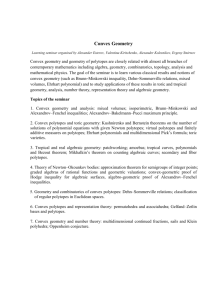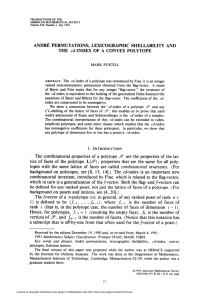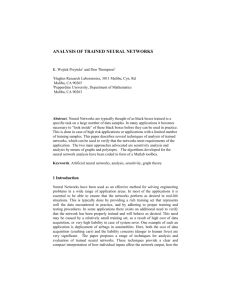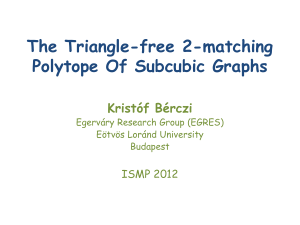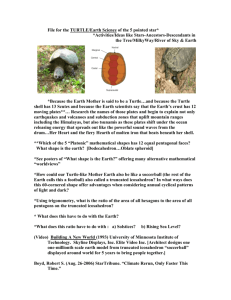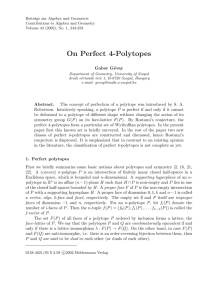Four-Dimensional Polytope Projection Barn Raisings
advertisement
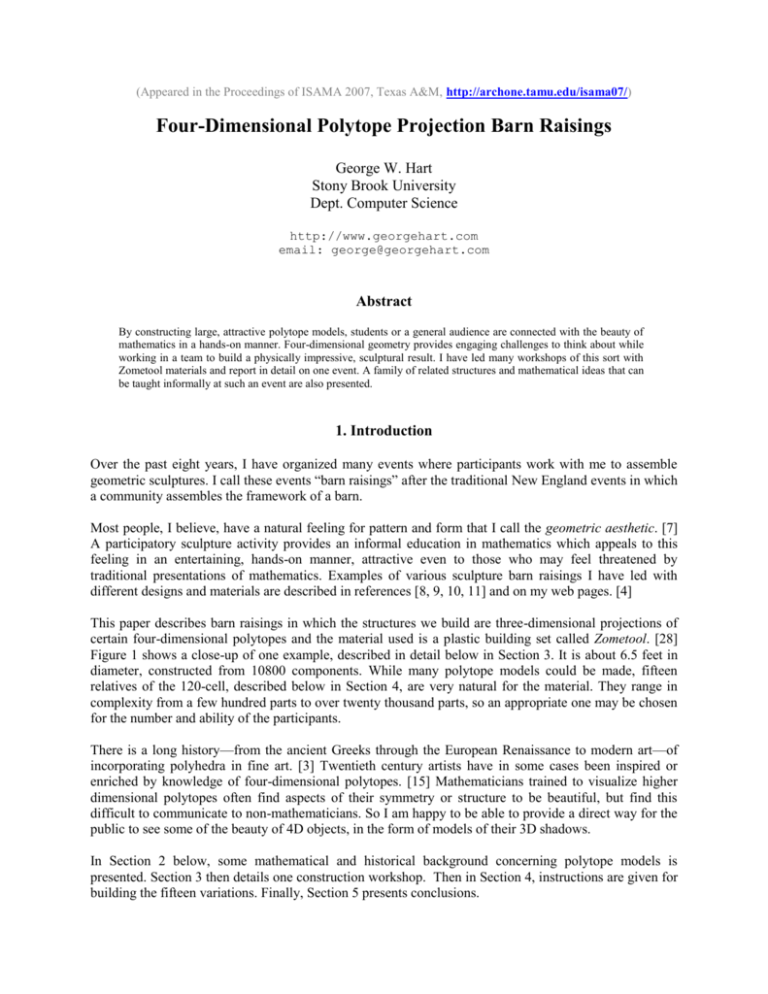
(Appeared in the Proceedings of ISAMA 2007, Texas A&M, http://archone.tamu.edu/isama07/) Four-Dimensional Polytope Projection Barn Raisings George W. Hart Stony Brook University Dept. Computer Science http://www.georgehart.com email: george@georgehart.com Abstract By constructing large, attractive polytope models, students or a general audience are connected with the beauty of mathematics in a hands-on manner. Four-dimensional geometry provides engaging challenges to think about while working in a team to build a physically impressive, sculptural result. I have led many workshops of this sort with Zometool materials and report in detail on one event. A family of related structures and mathematical ideas that can be taught informally at such an event are also presented. 1. Introduction Over the past eight years, I have organized many events where participants work with me to assemble geometric sculptures. I call these events “barn raisings” after the traditional New England events in which a community assembles the framework of a barn. Most people, I believe, have a natural feeling for pattern and form that I call the geometric aesthetic. [7] A participatory sculpture activity provides an informal education in mathematics which appeals to this feeling in an entertaining, hands-on manner, attractive even to those who may feel threatened by traditional presentations of mathematics. Examples of various sculpture barn raisings I have led with different designs and materials are described in references [8, 9, 10, 11] and on my web pages. [4] This paper describes barn raisings in which the structures we build are three-dimensional projections of certain four-dimensional polytopes and the material used is a plastic building set called Zometool. [28] Figure 1 shows a close-up of one example, described in detail below in Section 3. It is about 6.5 feet in diameter, constructed from 10800 components. While many polytope models could be made, fifteen relatives of the 120-cell, described below in Section 4, are very natural for the material. They range in complexity from a few hundred parts to over twenty thousand parts, so an appropriate one may be chosen for the number and ability of the participants. There is a long history—from the ancient Greeks through the European Renaissance to modern art—of incorporating polyhedra in fine art. [3] Twentieth century artists have in some cases been inspired or enriched by knowledge of four-dimensional polytopes. [15] Mathematicians trained to visualize higher dimensional polytopes often find aspects of their symmetry or structure to be beautiful, but find this difficult to communicate to non-mathematicians. So I am happy to be able to provide a direct way for the public to see some of the beauty of 4D objects, in the form of models of their 3D shadows. In Section 2 below, some mathematical and historical background concerning polytope models is presented. Section 3 then details one construction workshop. Then in Section 4, instructions are given for building the fifteen variations. Finally, Section 5 presents conclusions. Figure 1. Author and Zometool polytope model. Figure 2. Truncated icosahedron projected to 2D. 2. Polytopes This section collects mathematical ideas that I present casually in a workshop, as relevant parts of the model are being built. The term polytope generalizes polygons and polyhedra to n-dimensional (n-D) space. Segments are 1D polytopes. Polygons are 2D polytopes. Polyhedra are 3D polytopes. Mathematicians also study and make models of polytopes from 4D and higher-dimensional spaces. The boundary components of n-D polytopes are (n-1)-D polytopes. There are no physical 4D polytopes; we live in a 3D universe and can not construct physical 4D objects. However, it is important to see that ideal 3D geometric objects such as spheres and cubes also do not exist physically in our universe, only approximations to them exist. But this does not stop us from studying their properties. We derive properties of ideal mathematical objects and find ways to model and understand them. Projections provide one way to study ideal 4D objects. A 3D object held in sunlight casts a 2D shadow, a projection one dimension lower. Figure 2 illustrates this with a shadow of the edges of a truncated icosahedron, better known as the form of a soccer ball (in the US) or football (in Europe). Our visual systems can deal with two artifacts of this projection: (1) foreshortening causes the regular pentagons and hexagons of the 3D original to appear compressed in 2D; and (2) the front and back of the shadow overlay, giving a kind of “Necker cube effect”, e.g., we might see either of the two central pentagons in Figure 2 as the front. Except for the outer rim, all of Figure 2 is “double covered”. Analogously, we can calculate the 3D object that is the one-dimension-lower shadow of an envisioned four-dimensional object. The two types of artifacts mentioned above must be considered when interpreting these projections: (1) foreshortening results in 3D parts that appear compressed in 3D even though they derive from regular components in 4D; and (2) for the polytope projections considered here, there will be no “Necker cube effect” because the front and back shadows exactly overlap. But we must understand each part of the projection (except the outermost rim) to be a double coverage, representing two distinct parts of the original. The truncated icosahedron implied by Figure 2 is an example of a “uniform polyhedron,” meaning each face is regular and each vertex is equivalent. At each vertex of a soccer ball, one regular pentagon and two regular hexagons meet. The term “Archimedean” is sometimes used to describe such polyhedra. The 120-cell is a uniform 4D polytope consisting of 120 regular dodecahedra, four at each vertex, three around each edge. It is the simplest member of a family of fifteen uniform 4D polytopes related to each other by expansion and truncation. Alicia Boole Stott, in the early twentieth century and without any formal mathematical training, was the first to mathematically describe many members of the 120-cell family. [22, 24] Various people have made polytopes projection models using e.g., cardboard, or wire and thread [13, 19] or computer graphics [19, 27] or solid freeform fabrication [12]. More recently, it has been possible to construct even the most complex models from this family using Zometool. Zometool was designed around 1970 by the architect Steve Baer for purposes such as dome models. However, it incorporates lengths and angles that are useful for many other structures. [14] The parts fit together quickly and easily by friction, with no tools. So they are suitable for group construction projects with participants of all ages. I have found them ideal for polytope barn raisings. Figure 3. Start of Construction Figure 4. Truncated Icosahedron Modules 3. A Modern-Day Sangaku at Stony Brook University The polytope construction event described in this section took place at Stony Brook University, April 24, 2006. With announcements to the entire campus community, I promoted it as an interdisciplinary activity and exhibit, blending art, mathematics, computer science, and an aspect of traditional Asian culture. Sangaku (also written san gaku) is a Japanese tradition of celebrating geometrical beauty, popular during the Edo period (1603-1867) by members of all social classes. The traditional sangaku is a shaped wooden tablet on which a geometric problem or theorem is written with colorful paint. The tablet was displayed in a temple or shrine as an offering, as a puzzle for others to think over and understand, and as a way for the creator to show off the geometric discovery. Many are so beautiful that they are considered works of art. Although most sangaku are lost, almost nine hundred survive, scattered all throughout Japan. [23] I proposed to create a modern-day celebration of geometric beauty, in the tradition of sangaku, by leading members of the Stony Brook community in a large colorful geometric construction. Our temple or shrinelike environment for displaying the result was the Charles Wang center, which provides a serene atmosphere for people to contemplate the beauty of the geometric form. Although we updated to a threedimensional construction from the traditional two-dimensional tablet, its content, like many sangaku, contains numerous nested and tangent circles and spheres. Figure 3 shows the start of the construction with participants at work assembling various modules. Some of the required 10800 Zometool parts are on the tables. The complete structure requires 3660 nodes and 7140 struts. Specifically, 1440 short red, 1440, medium red, 2400 medium yellow, and 1860 medium blue struts are needed. Parts counts for planning this and related polytope models are discussed below. The components of a 3D polyhedron are 2D faces, e.g., a truncated icosahedron consists of twelve regular pentagons and twenty regular hexagons, which meet at edges. Analogously, one dimension up, a 4D polytope consists of 3D “cells” which meet at their faces. Our polytope contains three types of cells: 120 truncated icosahedra (TI), 600 truncated octahedra (TO), and 720 pentagonal prisms (PP). Various sequences are possible for constructing and assembling these cells. The plan I chose was to build the TI cells individually and join them with struts that outline the PPs. Doing this, the TOs are automatically formed in the spaces between the hexagons of neighboring TIs. Figure 4 shows some of the TI cells ready to be assembled together. They look like compressed soccer ball. There are different edge lengths and angles corresponding to different degrees of foreshortening. This is the result after an hour or two of construction. Teams of participants build first one type of cell, then another. They learn the different types of cells and see how they are related by foreshortening. Artists are familiar with the notion of foreshortening, e.g., a circle seen from an oblique angle is drawn on canvas as an ellipse, in accordance with the geometry of perspective. This transformation occurs when we project a 3D reality on to the restricted 2D space of the canvas. However it takes some hands on experience to understand that in 4D, all the cells of our polytope are quite symmetric, although they appear progressively flattened in 3D as we move away from the center. Figure 5. Partial Construction. Figure 6. Reaching the Top! Figure 5 shows the center module, a blue TI at the top center of the partial construction. We started with the center and worked our way toward the bottom. When complete, the center TI will be surrounded on twelve sides with a layer of slightly foreshortened TIs. Five struts are used to connect pentagon to pentagon, which creates cells in the form of PPs. Then additional layers of TIs surround these, each successively more foreshortened. A number of engineering considerations must be addressed during construction. Because we are making a large spherical form, 6.5 feet in diameter, it would be difficult to reach the top center if we saved it for last. So we first built a tall central core straight up to the top. This is shown in Figure 6. After the central core is formed, many people can work on it from all sides. Cells are added to the central core in pairs, always having two teams work simultaneously from opposite sides, so the structure can not become unbalanced and tip over. For strength, some vertical struts are added to carry the load, even though they are not part of the mathematical form. It would be great if in the future Zome manufactured clear parts to use for this purpose. Figure 7. Nearly Finished. Figure 8. Completed Polytope Model. Figure 7 shows the construction after 3.5 hours. We are attaching the outer layer of thirty cells that are completely foreshortened to two-dimensional flatness. Even before this point, I could walk away and let the group work out its own path to completion. During construction, I give specific mechanical instructions like “connect part A to part B” and a casual presentation of the mathematical ideas from Section 2. Each participant comes to their own understanding of the geometry, e.g., seeing it is uniform because four polyhedra meet at every vertex: a TI, a PP, and two TOs. I am always gratified to get to the point when some of the participants start answering the questions of others. When they can explain the process to each other and together solve the problems of how to attach the next cells, I know I have done my job as a teacher. Figure 8 shows the final result, after four hours, viewed along a 5-fold axis. It doesn't have any reasonable name. One name, used in Norman Johnson's upcoming book on uniform polytopes, is the Cantitruncated 600-cell. [16] One may also call it the Truncated Ambo 600-Cell as that may help in visualizing it. The projection model is impressive visually and for the amount of loving labor involved. Everyone finds it colorful and attractive and wants to have their photo taken with it. The views along its various symmetry axes are particularly impressive. In addition, I think that many people find these events fun because they are an intellectual challenge that presents stimulating new patterns and relationships to think about. 4. The Fifteen Related H4 Polytopes The above construction illustrates just one of the fifteen convex uniform 4D polytopes that can be built in a similar manner with Zometool. They share the same symmetry group, the Coxeter group, H4, of order 14400. [2, 20] Table 1 summarizes this set of polytopes, many of which I have built repeatedly at various workshops at universities, conferences [1, 21] or sundry places, e.g., as part of a geometry exhibit at the Chiang Kai-Shek Memorial in Taipei, Taiwan. For example, at the Matematica e Cultura conference in Venice, 2006, I was invited by Michele Emmer to do an outdoor public construction. This workshop took place in a lively city square in Venice, the Campo Sant' Angelo. Given the uncertainties of the environment, I chose a can’t-fail polytope that is very easy to parallelize: the expanded (or “runcinated”) 120-cell. Participants from the conference and curious members of the public worked together to assemble 4860 parts into a structure over a meter in diameter, shown in Figure 9. [5] Because of its very light and open form, my favorite of the fifteen is the truncated 120-cell. This was first constructed at a workshop I led at the Canada/USA MathCamp in UBC in Vancouver, in 2000. [17] Figure 10 shows one at a more recent construction I led at Dowling College, NY, in 2006. [6] It is rather fragile and requires a stable environment and cautious workers. Many other people have also made some of these models and/or organized polytope construction events, including Marc Pelletier, Steve Rogers, Paul Hildebrandt, Mira Bernstein, Vin de Silva, David Richter, and Dan Duddy. A web page with links to photos of some of these constructions is maintained by Dave Richter. [26] Recently, the larger models have been possible, due to Zome’s redesign for tighter connections and a shorter length of parts. The largest of the fifteen has 21360 parts. It was first constructed at the London Bridges 2006 Conference [1] in all-day event organized by Hildebrandt, Duddy, and Richter. We expect the model will be displayed at the London Science Museum. For others who may wish to organize such events, I offer the following suggestions. First, become familiar with Zometool and make the 120-cell. Instructions for it are available in [14] and in a special 120-cell kit which Zome sells. The truncated 120-cell is also outlined in [14]. When making the 120-cell, observe there are four important types of location. The fifteen H4 polytopes differ in terms of what sort of cell, if any, appears at each type of location. Name these locations I, T, P5, and P3 as follows: The centers of the dodecahedra are locations of icosahedral symmetry (I). The vertices of the 120-cell are locations of tetrahedral symmetry (T). The pentagon face centers are locations of pentagonal prism symmetry (P5). The midpoints of the struts are locations of triangular prism symmetry (P3). Table 1 shows which sort of cell to place at each location in each polytope. All fifteen polytopes can be made with the same four types of struts: short red, medium red, medium yellow, and medium blue. The parts count for each is given in Table 1, as derived by Richter. [25] There is always the same number of the two red lengths, so only one column is given for reds. The strut lengths can be scaled down to Zome’s new smaller sizes for more rigid models. Ultimately, it would be magnificent to build all fifteen as an exhibit at a single location, so one can directly see the connections between them. If this is done, I propose that the fifteen be arranged in space in a giant tetrahedron formation, which would be a kind of “periodic table” of their relationships. Coxeter provides a construction for these polytopes in terms of a vertex lying on zero, one, two, or three of the four mirror planes that generate the group. [2] The four vertices of the tetrahedron formation correspond to the four mirror planes. The four polytopes that are generated by the vertex off just one mirror plane would be at the corners of the tetrahedron. The six polytopes that correspond to the vertex lying off two mirrors would be at the corresponding edge midpoints. The four polytopes that correspond to the vertex lying off three mirrors would be at the tetrahedron’s face centers. And the remaining and most complex polytope, in which the vertex lies off all four mirrors, would command the tetrahedron’s center. Figure 9. A Polytope in Venice Figure 10. Truncated 120-Cell Table 1 includes Norman Johnson’s names. [16] The Wythoff symbol has four bits of information, corresponding to the four generating mirror planes. [2] The entry 0 or 1 corresponds to the vertex lying on or off the corresponding mirror. The I, T, P5, and P3 columns list which type of cell appears at each location. The cell types are abbreviated as: T=tetrahedron, O=octahedron, CO=cuboctahedron, I=icosahedron, D=dodecahedron, ID=icosidodecahedron, rID=rhombicosidodecahedron, t=truncated, and Pn=n-gon prism. In 4D, there are 120 of whatever cell appears in the I column, 600 of the cell appearing in the T column, 720 of the cell in the P5 column, and 1200 of the cell in the P3 column. But in the 3D projection, because the front and back overlap (see Section 2) there are only seventy-five type I cells to build. This is 1+12+20+12+30 in five layers from center to exterior. 5. Conclusions The lengths and angles built into Zometool make it relatively easy to build beautiful, large models of 4D polytopes from the H4 family. For several years, I have been going around the world leading polytope barn raisings. One event, presented as a modern-day sangaku, was described in some detail. Others are similar but with different modules. In the process of construction, there are many opportunities to introduce the underlying mathematical ideas casually. These hands-on activities introduce mathematical ideas in an informal non-threatening way. The interpersonal dynamics of a large group of people working over an extended time towards a challenging goal results in a different type of learning experience than most people associate with mathematics. Group activities such as this are one way to move mathematics in the stream of popular culture. In addition to the colorful attractiveness of the 3D model, participants appreciate abstract ideas of higherdimensional geometry, which hold their own form beauty. In similar workshops, I have had the participants construct other polytopes and other families of models such as fractals, but that is beyond the scope of this article. Acknowledgements Thank you to everyone who participated in all my barn raisings and to Zometool for providing the parts for many of these constructions. This paper benefits from discussions with many people who have participated in workshops with me over the years. Wythoff 0001 0010 0011 0100 0101 0110 0111 1000 1001 1010 1011 1100 1101 1110 1111 I . I I ID ID tI tI D D rID rID tD tD tID tID T T O tT T CO tT tO . T O tT T CO tT tO P5 . . . . P5 . P5 . P5 . P5 . P10 . P10 P3 . . . . . . . . P3 P3 P6 . P3 P3 P6 Parts Balls Reds Yellow Blue 351 75 72 120 120 2196 396 360 600 480 2964 780 432 720 600 2440 640 360 600 480 7200 1860 1080 1800 1380 5460 1860 720 1200 960 10800 3660 1440 2400 1860 950 330 120 200 180 4860 1260 720 1200 960 7200 1860 1080 1800 1380 12540 3660 1800 3000 2280 3680 1260 480 800 660 12540 3660 1800 3000 2280 10800 3660 1440 2400 1860 21360 7200 2880 4800 3600 Table 1. Data for Fifteen H4 Polytopes Name 600-cell Rectified 600-cell Truncated 600-cell Rectified 120-cell Cantellated 600-cell Bitruncated 120-cell Cantitruncated 600-cell 120-cell Runcinated 120-cell Cantellated 120-cell Runcitruncated 600-cell Truncated 120-cell Runcitruncated 120-cell Cantitruncated 120-cell Omnitruncated 120-cell References [1] Bridges Conference, http://www.bridgesmathart.org [2] H.S.M. Coxeter, Regular Polytopes, 1963, (Dover reprint, 1973). [3] Michele Emmer, ed., The Visual Mind, MIT Press, 1993. [4] G.W. Hart, http://www.georgehart.com [5] G. Hart, “A Public Polytope in Venice,” to appear, Mathematica e Cultura, Michele Emmer, ed., 2007. [6] G. Hart, “More than Three Dimensions: The Truncated 120 Cell” in Hyperseeing, the online newsletter of the International Society of Art, Math, and Architecture, http://www.isama.org, Dec., 2006. [7] G. Hart, "The Geometric Aesthetic," in The Visual Mind II, Michele Emmer (ed.), MIT Press, 2005. [8] G. Hart, "A Salamander Sculpture Barn Raising", Proceedings of Bridges 2004: Mathematical Connections in Art, Music, and Science, Southwestern College, Winfield, Kansas, July 2004, and in Visual Mathematics 7, no. 1, 2005. [9] G. Hart, "Spaghetti Code: A Sculpture Barnraising", Proceedings of Art+Math=X International Conference, University of Colorado, Boulder, June 2005, pp. 88-92. [10] G. Hart, "A Reconstructible Geometric Sculpture", Proceedings of ISAMA CTI 2004, DePaul University, June 17-19, 2004, Stephen Luecking ed., pp. 141-143. [11] G. Hart, "The Millennium Bookball," in Proceedings of Bridges 2000: Mathematical Connections in Art, Music and Science, Southwestern College, Winfield, Kansas, July 28-30, 2000, and in Visual Mathematics 2(3) 2000. [12] G. Hart, "Solid-Segment Sculptures," in Mathematics and Art: Mathematical Visualization in Art and Education, Claude Bruter (ed.), Springer Verlag, 2002. [13] G. Hart, “4D Polytope Projection Models by 3D Printing”, to appear in Hyperspace. [14] G.W. Hart and Henri Picciotto, Zome Geometry: Hands-on Learning with Zome Models, Key Curriculum Press, 2001. [15] Linda Dalrymple Henderson, The Fourth Dimension and Non-Euclidean Geometry in Modern Art, Princeton Univ. Pr., 1983. [16] Norman Johnson, Uniform Polytopes, Cambridge Univ. Pr., to appear. [17] MathCamp, http://www.mathcamp.org [18] Koji Miyazaki, An Adventure in Multidimensional Space: The Art and Geometry of Polygons, Polyhedra, and Polytopes, Wiley, 1983. [19] Koji Miyazaki, Hyperstructures, (in Japanese), 2005. [20] George Olshevsky, http://members.aol.com/Polycell/uniform.html [21] Ivars Peterson, “Polyhedron Man”, Science News, Dec. 22, 2001, Vol. 160, No. 25/26, p. 396. [22] Tony Phillips, “The Princess of Polytopia: Alicia Boole Stott and the 120-Cell”, American Mathematical Society online feature column, Oct. 2006, http://www.ams.org/featurecolumn/archive/index.html [23] Rothman, T. "Japanese Temple Geometry." Sci. Amer. 278, pp. 85-91, May 1998. [24] Alicia Boole Stott, "Geometrical deduction of semiregular from regular polytopes and space fillings," Verhandelingen der Koninklijke Akademie van Wetenschappen te Amsterdam, (eerste sectie), Vol. 11, No. 1, pp. 1-24 plus 3 plates, 1910. [25] David Richter, “Two Results Concerning the Zome Model of the 600-Cell”, in Renaissance Banff, Proceedings of Bridges 2005: Mathematical Connections in Art, Music and Science, pp. 419-426. [26] David Richter, http://homepages.wmich.edu/~drichter/ [27] Scott Vorthmann, vZome software, http://www.vorthmann.org/zome/ [28] Zometool Corporation, http://www.zometool.com

